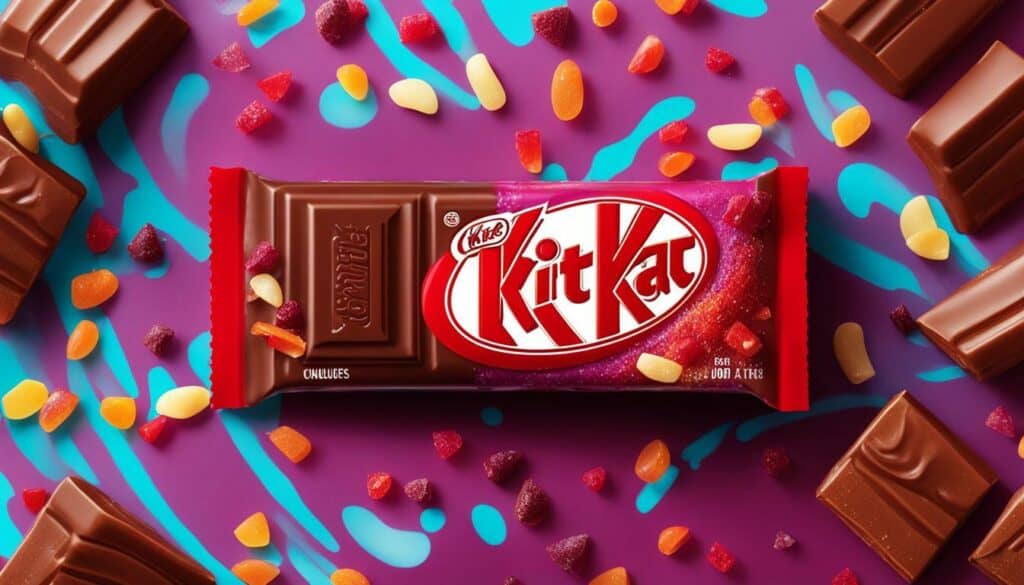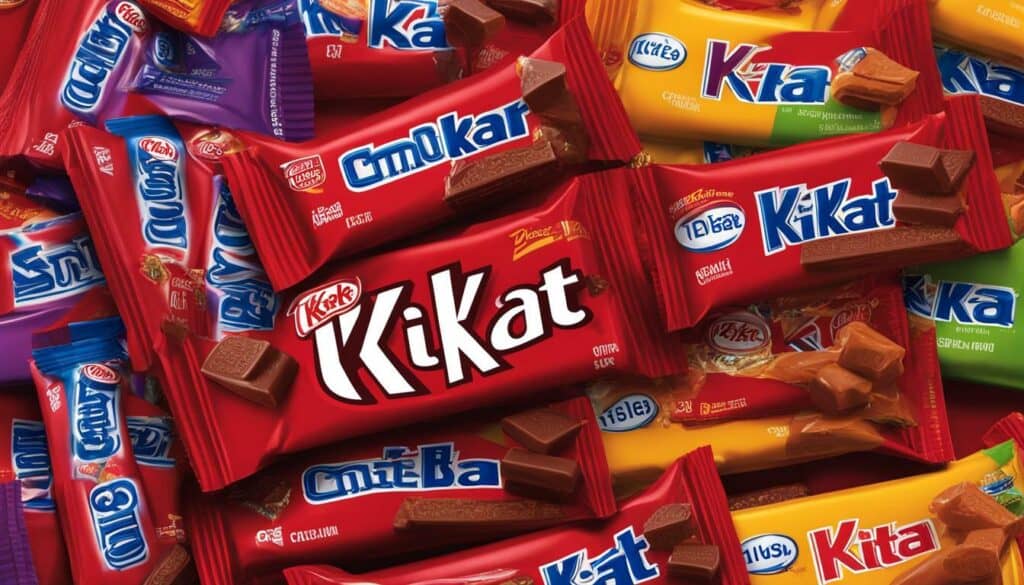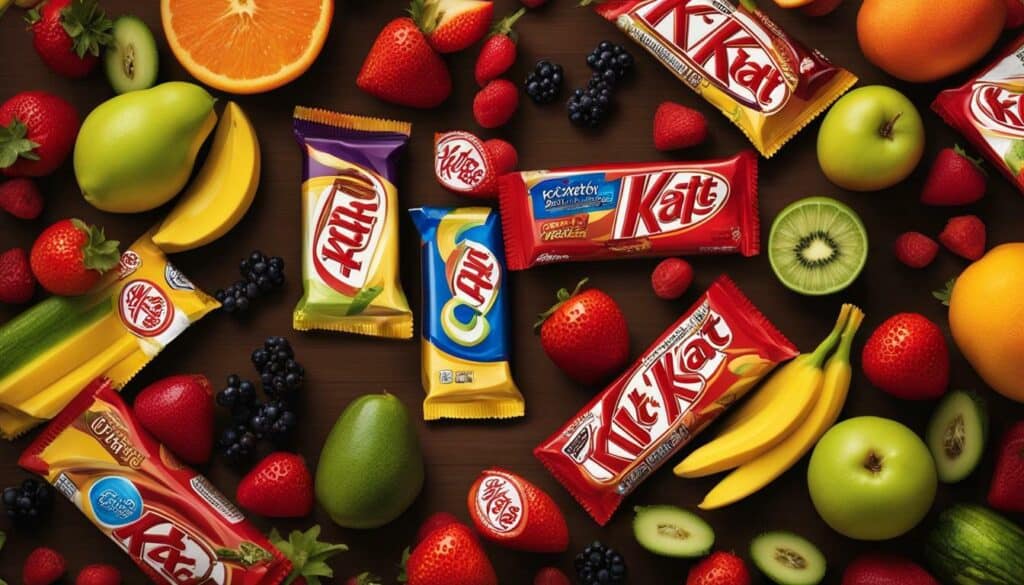Are you curious about the nutritional facts behind your favorite Kit Kat bars? Let’s explore the Kit Kat nutritional information together!
When it comes to satisfying your sweet tooth, Kit Kat bars are a popular choice. But have you ever wondered about the nutritional content of these delightful treats? In this section, we will uncover the key information you need to know about the nutritional profile of Kit Kat bars.
Before we dive into the details, let’s start with some basic facts. A typical serving size of a Kit Kat bar is 42 grams or one four-piece bar. Within this serving, you’ll find 210 calories, making it a moderate indulgence for your snack time.
Now, let’s break down the components of a Kit Kat bar. Each bar contains 11 grams of fat, with 7 grams being saturated fat. This means that while it does contain some fat, it’s important to enjoy it in moderation as part of a balanced diet.
In terms of carbohydrates, a Kit Kat bar provides 27 grams, including 20 grams of sugar. While it’s no surprise that these bars contain sugar, it’s worth noting the amount and incorporating it into your overall daily intake.
For those watching their protein intake, each Kit Kat bar offers 3 grams of protein, providing a small boost for your body’s needs. Additionally, there are 30 milligrams of sodium present in each bar.
When it comes to allergen information, it’s important to note that Kit Kat bars contain wheat, milk, and soy ingredients. If you have allergies or intolerances to these substances, it’s crucial to be aware before indulging in a Kit Kat.
Now, let’s talk flavors. Kit Kat bars come in various flavors, each with its own unique nutritional profile. Some popular options include Dark Chocolate, White Chocolate, and Matcha Green Tea. If you’re looking for a different taste experience, be sure to consider the nutritional differences between these variations.
As with any treat, it’s essential to enjoy Kit Kat bars in moderation. They can be part of a balanced diet, but it’s best to savor them as occasional indulgences rather than regular snacks.
Key Takeaways:
- Kit Kat bars have a serving size of one four-piece bar, containing 210 calories.
- Each bar contains 11 grams of fat, with 7 grams being saturated fat.
- Kit Kat bars provide 27 grams of carbohydrates, including 20 grams of sugar.
- They offer 3 grams of protein and 30 milligrams of sodium.
- Kit Kat bars contain wheat, milk, and soy ingredients, and may also contain peanuts or tree nuts.
Now that you have a better understanding of the nutritional information of Kit Kat bars, you can make informed choices about including them in your diet. Remember, everything is best enjoyed in moderation!
Kit Kat Calories and Serving Size

When it comes to Kit Kat bars, understanding the calorie content and serving size is key to making informed choices. A serving size of a Kit Kat bar is typically 42 grams or one four-piece bar, which contains 210 calories. This means that if you consume the entire bar, you will be consuming 210 calories from it alone.
In addition to the calorie count, it’s important to note the macronutrient breakdown of Kit Kat bars. Each bar contains 11 grams of fat, with 7 grams being saturated fat. Saturated fat is known to raise bad cholesterol levels in the body, so it’s essential to consume it in moderation. The bar also has 27 grams of carbohydrates, including 20 grams of sugar and less than 1 gram of dietary fiber. It’s important to be mindful of the sugar content and its impact on your overall diet.
Furthermore, each Kit Kat bar contains 3 grams of protein, providing a small amount of this essential nutrient. Protein is important for building and repairing tissues in the body. Additionally, the bar contains 30 milligrams of sodium, so individuals who need to monitor their sodium intake should be aware of this.
| Calories | Fat (g) | Saturated Fat (g) | Carbohydrates (g) | Sugar (g) | Protein (g) | Sodium (mg) |
|---|---|---|---|---|---|---|
| 210 | 11 | 7 | 27 | 20 | 3 | 30 |
It’s important to note that Kit Kat bars contain wheat, milk, and soy ingredients, and may also contain peanuts or tree nuts. Therefore, individuals with allergies or dietary restrictions should be cautious when consuming these bars.
Various flavors of Kit Kat bars are available, such as Dark Chocolate, White Chocolate, and Matcha Green Tea. These flavors have different nutritional profiles, so it’s important to read the labels or refer to the manufacturer’s website for specific information on each flavor.
Remember, enjoying Kit Kat bars in moderation as part of a balanced diet is key. While they can be a delicious treat, it’s important to consider their nutritional content and incorporate them into a well-rounded eating plan.
Kit Kat Fat Content
Let’s take a closer look at the amount of fat you can find in each delicious Kit Kat bar. A serving size of a Kit Kat bar is typically 42 grams or one four-piece bar. In each bar, you’ll find 11 grams of fat, with 7 grams being saturated fat. Saturated fats are known to raise cholesterol levels, so it’s important to consume them in moderation.
While fat is an essential nutrient for our bodies, it’s important to be mindful of our intake. Kit Kat bars contain both saturated and unsaturated fats. Unsaturated fats, such as those found in nuts and avocados, are considered healthier fats and can help promote heart health. However, it’s still important to consume them in moderation, as excess fat intake can contribute to weight gain and other health issues.
It’s worth noting that Kit Kat bars also contain 27 grams of carbohydrates, including 20 grams of sugar. Carbohydrates provide energy for our bodies, but excessive sugar intake can negatively impact our health. As with fat, it’s important to enjoy Kit Kat bars in moderation and as part of a balanced diet.
In summary, a serving of Kit Kat bars contains 11 grams of fat, including 7 grams of saturated fat. Enjoy them as an occasional treat, keeping in mind the importance of moderation and a balanced diet. Indulging in your favorite Kit Kat flavor can be a delightful experience, but it’s always wise to be mindful of the nutritional content and make informed choices that align with your dietary needs and goals.
Kit Kat Sugar Content
Sugar lovers, this section will satisfy your curiosity about the sugar content of Kit Kat bars. When indulging in this popular chocolate wafer treat, it’s important to be aware of the amount of sugar it contains. A serving size of a Kit Kat bar is typically 42 grams or one four-piece bar, and it contains 20 grams of sugar. That’s equivalent to about 5 teaspoons of sugar per bar. While it’s understandable to enjoy the sweetness of Kit Kat bars, it’s crucial to be mindful of your sugar intake and consume them in moderation.
It’s worth mentioning that Kit Kat bars also contain carbohydrates from sources other than sugar. In each bar, you’ll find 27 grams of carbohydrates, which include both sugars and dietary fiber. While there is a relatively high amount of sugar in Kit Kat bars, they only provide less than 1 gram of dietary fiber per serving. This means that the majority of carbohydrates in Kit Kat bars come from sugars rather than fiber.
For those who are interested in maintaining a balanced diet, it’s important to consider the overall nutritional profile of Kit Kat bars. While they do provide a sweet treat, they should be enjoyed in moderation as part of a well-rounded eating plan. Remember that consuming excessive amounts of sugar can have negative effects on your health, including weight gain and an increased risk of chronic diseases. By being aware of the sugar content in Kit Kat bars, you can make informed choices about when and how often to include them in your diet.
| Nutrient | Amount per Serving |
|---|---|
| Calories | 210 |
| Total Fat | 11g |
| Saturated Fat | 7g |
| Carbohydrates | 27g |
| Sugar | 20g |
| Dietary Fiber | <1g |
| Protein | 3g |
| Sodium | 30mg |
While Kit Kat bars can bring joy and sweetness to your day, always remember to savor them in moderation and alongside a balanced diet. The nutritional information provided will assist you in making informed choices about your sugar intake. So go ahead, enjoy the delightful crunch of a Kit Kat bar, but remember to keep your overall sugar consumption in check for optimal health.
Carbohydrates play a crucial role in our diet, so let’s discover the amount present in Kit Kat bars. A serving size of a Kit Kat bar is typically 42 grams or one four-piece bar, which contains 27 grams of carbohydrates. Out of these 27 grams, 20 grams are sugars, while the remaining carbohydrates come from other sources.
It’s important to note that Kit Kat bars do not contain any dietary fiber, as they have less than 1 gram per serving. While dietary fiber is an essential part of a healthy diet, it is not found in significant amounts in this particular treat.
To give you a better understanding of the nutritional content of Kit Kat bars, let’s take a closer look at the breakdown of carbohydrates. In each serving, you’ll find a combination of simple sugars and complex carbohydrates. Simple sugars, like the 20 grams of sugar in a Kit Kat bar, provide a quick source of energy. On the other hand, complex carbohydrates take longer to break down and provide a sustained release of energy.

When enjoying a Kit Kat bar, it’s important to keep in mind that it contains 210 calories, 11 grams of fat, and 3 grams of protein. It also contains 30 milligrams of sodium. Additionally, please be aware that Kit Kat bars may contain allergens such as wheat, milk, soy, peanuts, and tree nuts. If you have any specific dietary restrictions or allergies, it’s always best to check the label for detailed ingredient information.
While it’s perfectly fine to enjoy a Kit Kat bar as an occasional treat, it’s recommended to consume them in moderation as part of a balanced diet. By incorporating variety and mindful eating habits, you can enjoy your favorite Kit Kat flavors while still maintaining a healthy lifestyle.
Kit Kat Protein Content
Protein is an essential macronutrient, and we’ll explore how much is packed into each Kit Kat bar. A serving size of a Kit Kat bar is typically 42 grams or one four-piece bar, which contains 210 calories. When it comes to protein, each bar provides 3 grams, contributing to your daily intake.
To put this into perspective, the protein content in a Kit Kat bar is relatively low compared to other protein-rich snacks or meals. However, it still plays a role in providing some satiety and contributing to your overall nutrition. It’s important to remember that Kit Kat bars are primarily enjoyed for their delicious taste rather than being a significant source of protein.
Aside from protein, Kit Kat bars contain other macronutrients, including fat and carbohydrates. Each bar contains 11 grams of fat, with 7 grams being saturated fat. The carbohydrate content is 27 grams, including 20 grams of sugar and less than 1 gram of dietary fiber. Additionally, there are 30 milligrams of sodium in each Kit Kat bar.

Kit Kat bars may also contain allergens such as wheat, milk, soy, peanuts, and tree nuts. It’s important to be mindful of these ingredients if you have any allergies or dietary restrictions.
It’s worth noting that various flavors of Kit Kat bars are available, each with its own unique nutritional profile. For example, Dark Chocolate, White Chocolate, and Matcha Green Tea flavors may have slightly different amounts of protein, fat, and carbohydrates compared to the original milk chocolate Kit Kat. So, if you’re looking to enjoy a Kit Kat while watching your nutritional intake, consider exploring the different flavors and their respective nutritional profiles.
| Nutrient | Amount per Serving (42g) |
|---|---|
| Calories | 210 |
| Protein | 3g |
| Fat | 11g |
| Saturated Fat | 7g |
| Carbohydrates | 27g |
| Sugars | 20g |
| Dietary Fiber | <1g |
| Sodium | 30mg |
Kit Kat Ingredients
Ever wondered what goes into making a scrumptious Kit Kat bar? Let’s examine its ingredients. Kit Kat bars are made with a combination of simple, yet delicious ingredients. The main components include:
- Wheat flour: Provides the base for the crispy wafer layers.
- Sugar: Adds sweetness and enhances the flavor.
- Vegetable oil: Helps maintain the texture and keeps the bars fresh.
- Skim milk powder: Contributes to the creamy and smooth taste.
- Cocoa mass: Gives the chocolate coating its rich and indulgent flavor.
- Cocoa butter: Adds a velvety texture to the chocolate coating.
- Lactose: A natural sugar found in milk, this ingredient adds a touch of sweetness.
- Emulsifier (soy lecithin): Helps bind the ingredients together and prevent separation.
- Yeast: A leavening agent that aids in the fermentation of the wafer layers.
- Natural and artificial flavors: These provide the distinct Kit Kat taste we all know and love.
It’s important to note that while Kit Kat bars do not contain peanuts or tree nuts in their standard formulation, they are manufactured in facilities that handle these ingredients. As a result, there is a potential risk of cross-contamination. If you have a nut allergy, it’s always best to check the packaging for allergen information.
Now that we’ve uncovered the ingredients that make up a Kit Kat bar, you can appreciate the thoughtfulness put into creating this iconic treat. The combination of crispy wafers, creamy chocolate, and a touch of sweetness makes Kit Kat an irresistible indulgence for chocolate lovers worldwide.
| Nutritional Information | Per Serving (42g) |
|---|---|
| Calories | 210 |
| Total Fat | 11g |
| Saturated Fat | 7g |
| Carbohydrates | 27g |
| Sugar | 20g |
| Dietary Fiber | |
| Protein | 3g |
| Sodium | 30mg |
Kit Kat Nutrition Facts
Get ready to discover the complete nutrition facts of Kit Kat bars, so you can make informed choices. A serving size of a Kit Kat bar is typically 42 grams or one four-piece bar, which contains 210 calories. Each bar contains 11 grams of fat, with 7 grams being saturated fat. The bar also has 27 grams of carbohydrates, including 20 grams of sugar and less than 1 gram of dietary fiber. There are 3 grams of protein and 30 milligrams of sodium in each Kit Kat bar.
To give you a better understanding of the nutritional content, let’s break it down further. According to the American Heart Association, the recommended daily intake of calories for an average adult is around 2,000 to 2,500 calories. With each Kit Kat bar accounting for 210 calories, it can be enjoyed as a guilt-free treat within your daily calorie allowance.
However, it’s important to note that Kit Kat bars are not a significant source of essential nutrients. While they provide a sweet indulgence, they should be consumed in moderation as part of a balanced diet. If you’re aiming to meet your daily nutrient needs, it’s crucial to focus on nutrient-rich foods such as fruits, vegetables, lean proteins, whole grains, and healthy fats.
The Importance of Mindful Consumption
“All things in moderation.” – Anonymous
Moderation is key when it comes to enjoying Kit Kat bars. Treat yourself to a bar every now and then, but be mindful of your overall diet and health goals. Remember, indulging in a sweet treat can be part of a healthy lifestyle as long as it’s done in moderation.
It’s also worth noting that Kit Kat offers a range of flavors, such as Dark Chocolate, White Chocolate, and Matcha Green Tea, each with its own unique nutritional profile. If you’re curious about the specific nutritional content of these flavors, make sure to check the packaging or do some quick research online.
| Nutrition Information | Amount Per Serving (42g) |
|---|---|
| Calories | 210 |
| Total Fat | 11g |
| Saturated Fat | 7g |
| Carbohydrates | 27g |
| Sugar | 20g |
| Dietary Fiber | <1g |
| Protein | 3g |
| Sodium | 30mg |
Remember, enjoying Kit Kat bars in moderation and as part of a balanced diet can still bring joy and satisfaction to your sweet tooth cravings. So go ahead, indulge a little and savor each delicious bite!

Kit Kat offers a range of tantalizing flavors, and we’ll explore how their nutritional profiles differ. Whether you’re a fan of classic milk chocolate or looking for something more exotic, Kit Kat has a flavor to satisfy every craving.
Let’s start with Dark Chocolate. This rich and indulgent flavor is perfect for those who prefer a bolder taste. A four-piece serving of Dark Chocolate Kit Kat has 210 calories, 12 grams of fat (8 grams saturated), 28 grams of carbohydrates (19 grams of sugar), and 3 grams of protein. It’s important to note that Dark Chocolate Kit Kat contains slightly more fat and fewer carbohydrates compared to the classic milk chocolate variety.
If you’re a fan of creamy white chocolate, the White Chocolate Kit Kat is a must-try. A four-piece serving of White Chocolate Kit Kat also has 210 calories, 12 grams of fat (8 grams saturated), 27 grams of carbohydrates (19 grams of sugar), and 3 grams of protein. Similar to the Dark Chocolate flavor, White Chocolate Kit Kat has a comparable nutritional profile to the classic milk chocolate version.
For those seeking a unique and refreshing flavor, Matcha Green Tea Kit Kat is the way to go. This flavor combines the delicate bitterness of matcha with the sweetness of chocolate. A four-piece serving of Matcha Green Tea Kit Kat contains 210 calories, 12 grams of fat (7 grams saturated), 26 grams of carbohydrates (18 grams of sugar), and 3 grams of protein. The Matcha Green Tea flavor has a slightly lower sugar content compared to the other flavors, making it a great choice for those watching their sugar intake.
| Flavor | Calories | Total Fat (g) | Saturated Fat (g) | Carbohydrates (g) | Sugar (g) | Protein (g) |
|---|---|---|---|---|---|---|
| Classic Milk Chocolate | 210 | 11 | 7 | 27 | 20 | 3 |
| Dark Chocolate | 210 | 12 | 8 | 28 | 19 | 3 |
| White Chocolate | 210 | 12 | 8 | 27 | 19 | 3 |
| Matcha Green Tea | 210 | 12 | 7 | 26 | 18 | 3 |
Remember, while Kit Kat bars are a delicious treat, it’s important to consume them in moderation as part of a balanced diet. Enjoying a Kit Kat bar as an occasional indulgence can be a delightful way to satisfy your sweet tooth without derailing your nutritional goals.
If you have specific dietary restrictions or allergies, it’s important to be aware of potential allergens in Kit Kat bars. These popular chocolate bars contain several ingredients that may cause adverse reactions in some individuals. The main allergens present in Kit Kat bars include wheat, milk, and soy.
Kit Kat bars are made with wheat, which contains gluten. Individuals with gluten intolerance or celiac disease should avoid consuming these bars. Additionally, Kit Kat bars contain milk and soy ingredients. People with lactose intolerance or dairy allergies should exercise caution when consuming these bars, as they may experience digestive issues or allergic reactions.
It’s also worth noting that Kit Kat bars may come into contact with peanuts or tree nuts during the manufacturing process. While peanuts and tree nuts are not listed as ingredients in the bars, there is a risk of cross-contamination. Individuals with nut allergies should consult the packaging or contact the manufacturer for specific information.
Table: Allergens in Kit Kat Bars
| Allergens | Potential Presence |
|---|---|
| Wheat | Yes |
| Milk | Yes |
| Soy | Yes |
| Peanuts | Possible cross-contamination |
| Tree Nuts | Possible cross-contamination |

It’s crucial to carefully read the packaging and labels of Kit Kat bars, as manufacturers may update their ingredients or processing methods without notice. If you have severe allergies or dietary restrictions, it’s always best to consult with a healthcare professional or allergist before consuming any food product.
Remember, enjoying Kit Kat bars in moderation is key. They can be a delicious treat as part of a balanced diet, but it’s important to be mindful of your individual dietary needs and limitations.
Enjoying Kit Kat Bars in Moderation
While indulging in Kit Kat bars is delightful, it’s essential to enjoy them responsibly as part of a well-rounded diet. These crispy wafer bars coated in smooth chocolate may satisfy your sweet tooth, but it’s important to be mindful of their nutritional content. A single Kit Kat bar has 210 calories, 11 grams of fat, and 27 grams of carbohydrates. It also contains 20 grams of sugar, so it’s wise to consume them in moderation to maintain a balanced diet.
One way to enjoy Kit Kat bars while managing your calorie intake is to savor them as an occasional treat rather than a daily indulgence. You can also consider breaking the bar into smaller portions and sharing it with friends or family. This allows you to enjoy the taste without consuming excessive calories in one sitting.
When incorporating Kit Kat bars into your diet, it’s important to balance them with other nutrient-rich foods. Try pairing them with a source of protein, like a handful of nuts or a glass of milk, to add more nutritional value to your snack. Remember that variety is key, so don’t rely solely on Kit Kat bars for your sweet cravings. Incorporate a range of fruits, vegetables, whole grains, and lean proteins into your diet for optimal health.
Tips for Mindful Consumption of Kit Kat Bars
- Enjoy Kit Kat bars as an occasional treat rather than a daily staple.
- Break the bar into smaller portions and share with others to manage calorie intake.
- Pair Kit Kat bars with a source of protein to add nutritional value to your snack.
- Incorporate a variety of nutrient-rich foods into your diet for overall health.
| Nutrition Facts | Per Serving (42g) |
|---|---|
| Calories | 210 |
| Total Fat | 11g |
| Saturated Fat | 7g |
| Carbohydrates | 27g |
| Sugar | 20g |
| Protein | 3g |
| Sodium | 30mg |
By enjoying Kit Kat bars in moderation and incorporating them into a well-balanced diet, you can indulge in their deliciousness without compromising your nutritional goals. Remember, it’s all about finding the right balance and savoring each bite.

Now that you’re equipped with the nutritional knowledge of Kit Kat bars, you can savor them with a better understanding of their impact on your diet.
A serving size of a Kit Kat bar is typically 42 grams or one four-piece bar, which contains 210 calories. Each bar contains 11 grams of fat, with 7 grams being saturated fat. The bar also has 27 grams of carbohydrates, including 20 grams of sugar and less than 1 gram of dietary fiber. There are 3 grams of protein and 30 milligrams of sodium in each Kit Kat bar.
It’s important to note that Kit Kat bars do contain wheat, milk, and soy ingredients, and may also contain peanuts or tree nuts. Therefore, individuals with allergies to these ingredients should exercise caution when consuming Kit Kat bars.
Additionally, various flavors of Kit Kat bars are available, such as Dark Chocolate, White Chocolate, and Matcha Green Tea, which have different nutritional profiles. These flavors may have variations in calorie, fat, and sugar content, so be sure to check the packaging for specific information.
Remember, enjoying Kit Kat bars in moderation is key. They can be a delicious treat when enjoyed as part of a balanced diet. So go ahead and savor each bite, knowing the nutritional information and making informed choices that fit your dietary needs and goals.
FAQ
Q: What is the serving size of a Kit Kat bar?
A: The serving size of a Kit Kat bar is typically 42 grams or one four-piece bar.
Q: How many calories are in a Kit Kat bar?
A: A Kit Kat bar contains 210 calories.
Q: How much fat is in a Kit Kat bar?
A: Each Kit Kat bar contains 11 grams of fat, with 7 grams being saturated fat.
Q: How much sugar is in a Kit Kat bar?
A: A Kit Kat bar has 20 grams of sugar.
Q: What is the carbohydrate content of a Kit Kat bar?
A: A Kit Kat bar contains 27 grams of carbohydrates.
Q: How much protein is in a Kit Kat bar?
A: Each Kit Kat bar has 3 grams of protein.
Q: Are there any allergens in Kit Kat bars?
A: Kit Kat bars contain wheat, milk, and soy ingredients, and may also contain peanuts or tree nuts.
Q: What are the different flavors of Kit Kat bars?
A: Kit Kat bars come in various flavors, such as Dark Chocolate, White Chocolate, and Matcha Green Tea, which have different nutritional profiles.
Q: How should I consume Kit Kat bars?
A: It’s important to consume Kit Kat bars in moderation as part of a balanced diet.
What are the Nutritional Facts of Viet Nomz Compared to Kit Kat?
Viet nomz nutrition information may drastically differ from that of Kit Kat. While Viet Nomz is a Vietnamese cuisine restaurant that focuses on fresh and healthy ingredients, Kit Kat is a popular chocolate bar. The nutritional facts of Viet Nomz are more likely to include nutrient-rich ingredients, while Kit Kat is typically high in sugar, saturated fat, and calories.





Leave a Reply